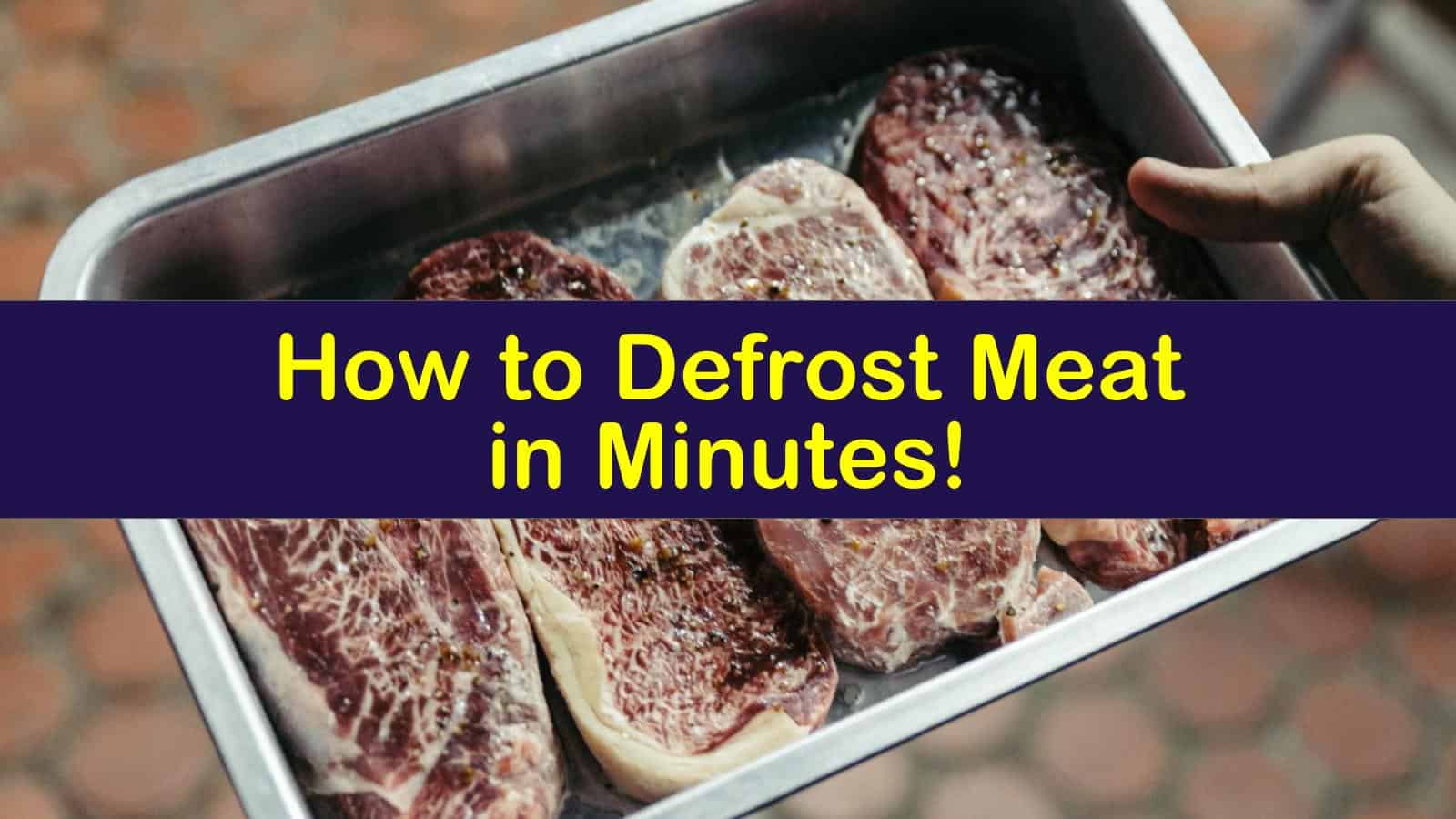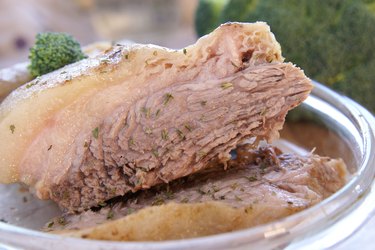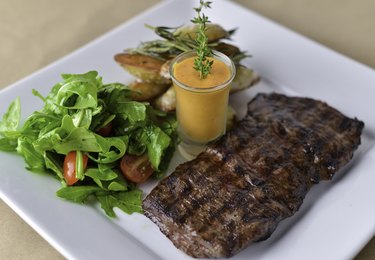Although it might be common practice, defrosting meat at room temperature can lead bacterial growth. In three safe ways, you can thaw meat. Depending on how it was thawed, the meat needs a different amount of time to cook.
If you need to thaw something quick, you can use the microwave. You can thaw meat in the refrigerator with some planning ahead. You can also thaw meat in cold water.
The USDA Food Safety and Inspection Service says that microwave and cold-water thawing need to be cooked right away, while thawing in the fridge can take anywhere from one to three days, depending on the type of meat.
The amount of time that food is safe after thawing varies by the method used to thaw it. Microwave and cold-water thawing require immediate cooking, while thawing in the fridge can buy you a few days.
Defrosting beef safely is essential, but so is properly handling and cooking it afterwards. Eating spoiled beef can cause serious food poisoning. So how long after thawing can beef sit in the fridge before it needs cooking?
This book tells you everything you need to know about thawing beef and figuring out when it should be cooked to make sure it is safe and tasty.
Overview of Defrosting Beef
Before cooking frozen beef must be thoroughly defrosted. There are a few safe methods
-
Refrigerator: Place frozen beef in refrigerator (40°F or below). Takes 1-2 days for roasts, 12-24 hours for steaks.
-
Cold Water Seal beef in airtight bag and submerge in cold water, changing water every 30 mins Takes 2-3 hours for roasts, 1 hour for steaks
-
Microwave: Follow microwave-safe defrosting instructions, stopping to flip/rearrange. Takes 15-30 mins.
Do not let beef defrost at room temperature or in hot water; this lets bacteria grow quickly.
Once defrosted, beef has a limited shelf life in the fridge before it must be cooked.
How Long After Defrosting Can Beef Be Refrigerated?
The timeline for safe refrigeration of defrosted beef depends on a few factors:
- Type of beef – Ground beef vs. steaks/roasts
- Defrosting method – Fridge vs. cold water vs. microwave
- Handling – Prevention of cross-contamination
Here are the general guidelines:
- Ground beef: 1-2 days
- Steaks, roasts, chops: 3-5 days
Store defrosted beef tightly wrapped on a shelf or tray. Never mix raw defrosted beef with other foods in the fridge.
If beef has been defrosted for longer than the times listed, it’s best to cook or refreeze it rather than risk eating spoiled meat.
Signs Beef Needs Cooking After Defrosting
Rely first on the recommended timeframes listed above. But also look for the following signs that defrosted beef has been in the fridge too long:
- Slimy texture – Slime on raw beef indicates bacteria growth
- Greyish color – Loss of vibrant redness
- Dull odor – Little or no beef aroma
- Off odors – Sour, rancid, or ammonia-like smell
If you notice any of these signs, don’t risk tasting the beef – cook it ASAP or discard it if the quality seems compromised. Don’t eat beef that seems questionable.
Storing Defrosted Beef for Later Use
If you aren’t ready to cook defrosted beef within the recommended fridge timelines, you have a couple options:
Refreeze Beef
- Only refreeze beef once after the initial defrost
- Beef may lose some moisture and texture from refreezing
- When ready to use, defrost again using a safe method
Freeze Portions for Later Use
- Divide beef into portions to be used over next few days
- Safely refreeze any unwanted portions immediately
- Thaw portions in fridge as needed
Avoid letting defrosted beef linger too long in the fridge. Refreeze or cook within the specified timeframes.
Cooking Defrosted Beef Safely
Once defrosted beef is cooked, it stops being a food safety risk. Follow these tips for safe cooking:
- Marinate properly – Only marinate for 1-2 days in fridge
- Prevent cross-contamination – Use separate plates, utensils for raw and cooked beef
- Cook thoroughly – Cook to safe internal temperature (145°F for steaks, 160°F for ground)
- Don’t reuse marinade – Boil marinade before serving as sauce
- Refrigerate leftovers – Store cooked beef within 2 hours, eat within 3-4 days
Thorough cooking and good refrigeration practices destroy any bacteria that may be present on raw defrosted beef.
Frequently Asked Questions
Can I cook beef immediately after defrosting in the microwave?
Yes, microwave defrosting can be followed immediately by cooking. The outside may be warm, but internal temps will still need to reach 145°F for steaks or 160°F for ground beef.
What if I forgot defrosted beef in the fridge for a week?
If beef has been defrosted for longer than the recommended 3-5 days, it is unsafe to cook and eat. The quality is also likely to be very compromised. Always discard beef that has sat in the fridge too long after thawing.
Is it safe to refreeze beef if I don’t plan to eat it within the 3-5 day timeframe?
Yes, refreezing defrosted beef is safe as long as it was thawed using safe fridge or cold water methods. Refreeze immediately, and defrost again when ready to cook. Only refreeze once.
Can I re-freeze cooked beef leftovers?
It is not recommended to re-freeze cooked beef. The texture and moisture will degrade. Portion and refrigerate leftovers for use within 3-4 days. Freeze any unwanted cooked portions before initial cooking.
What if I’m unsure how long the defrosted beef has been in my fridge?
When in doubt, throw it out. Don’t risk eating spoiled meat. Even if it looks okay, unknown duration in the fridge means potential bacterial growth. Cook fresh or properly defrosted beef only.
The Takeaway – Cook Defrosted Beef ASAP
Always cook or refreeze beef within 1-5 days after defrosting. Look for signs of spoilage like odor, texture, and color changes. Handle defrosted beef carefully to prevent contamination.
Cooking to proper temperatures destroys bacteria from defrosted beef, while refrigerating prevents further growth. Use safe defrosting, handling, cooking, and storage practices for maximum safety and quality.

Save Time With the Microwave
The microwave is a safe way to thaw meat, but make sure to take off all the plastic wrap and foam trays before you start. Thaw meat on low power so that the meat is heated more evenly.
The USDA Food Safety and Inspection Service says that after thawing the meat in the microwave, you should cook it right away in case some parts get too warm and start to cook.
This creates an ideal environment for the growth of bacteria, especially bacteria that was already present before the thawing process. Foodborne illness, such as salmonella infection, can occur from consumption of meat that is contaminated with bacteria, according to Mayo Clinic.
Read more: 5 Healthy Red Meat Recipes That Satisfy
You can thaw meat in the refrigerator with some advance planning because it takes some time. For example, a frozen turkey takes 24 hours to thaw for every 5 pounds of weight. It takes 24 hours to cook one pound of ground meat or chicken, but it could take longer if your fridge is below 40 degrees Fahrenheit, which is the best temperature.



The USDA Food Safety and Inspection Service says that ground meat, poultry, and seafood that have been frozen should be cooked within one or two days. Red meat, like beef steaks, lamb chops, and pork chops or roasts, needs to be cooked within three to five days of being thawed.
If meat has been thawed in the fridge, you can freeze it again without cooking it, but the quality may be affected.
Cold water is safe for thawing meat, but warm water or the counter is not. The meat gets too warm, which is good for bacteria to grow. Thawing in hot water can begin to cook your meat.
To thaw meat in cold water, place it in a leak-proof bag, submerge it in cold water and change the water every 30 minutes so it stays cold, explains the University of Illinois Extension. Cook meat thawed in cold water immediately, even before you refreeze it.
You can cook frozen meat without thawing it if you run out of time to thaw. Plan on cooking the meat at least 50 percent longer than if it were in a thawed state.
